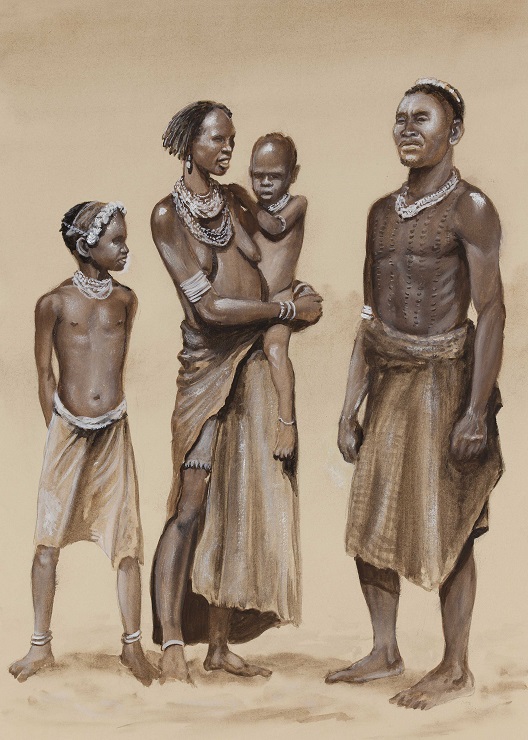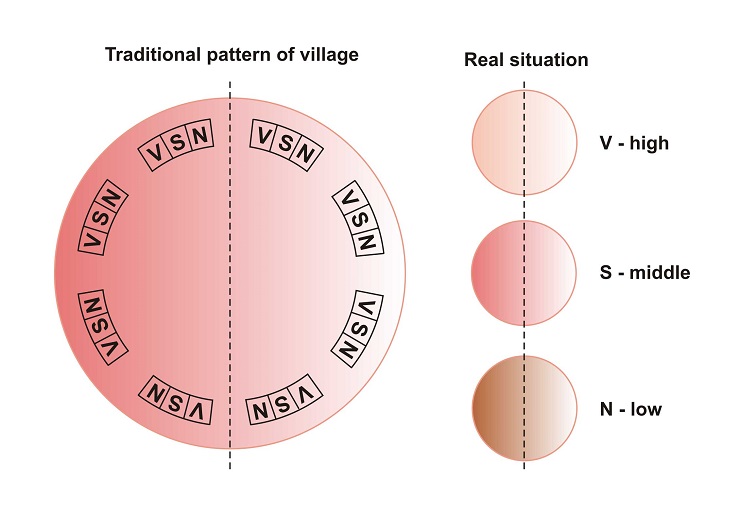The importance of kinship for defining the typology of archaic societies and their follow-up social processes had already been recognised by one of the leading anthropologists, Lewis Henry Morgan. On the basis of intercultural comparisons he defined six basic types of terminologically-based systems of kinship – each named after the society in which they typically existed. The Eskimo linear system still does not distinguish between relatives who belong to the maternal or the paternal line. The Sudanese system has a separate language term for each relative. The Hawaiian system distinguishes only between generations and genders (the word “father” also refers to all of the blood “uncles”). The Iroquois system distinguishes between the maternal and the paternal lines, whereby also associated with the mother was her sister and, in the same manner, the father with his brother. The last two systems were not ethnographically documented so frequently, but they operated on the same principle but in an opposite manner. Secondary line generations were not overtly identified but all the matrilineal and patrilineal male or female relatives were associated with them. This categorisation of Morgan’s illustrates the efforts that were made to identify links between the subjects of the world of archaic societies, while at the same time defining their differences from Western civilisation.
The kinship system of world cultures actually constitutes an elusive jumble of rules while at the same time denoting the exemptions from them that exist. The rules defined by native peoples often represent some kind of open-ended instructions, the failure of which would not induce any serious sanctions.
|
|
| A diagram showing a breakdown of the kinship of Keyara (Bororo, Brazil) defined by Claude Lévi-Strauss. |
 |
|
Although a family composed of a mother, a father and their offspring constitutes the societal base of both archaic and modern societies, between these two cultural worlds many of its parameters differ. E.g. frequently spouses do not share a dwelling or the father role is taken over by his wife’s brother. Illustration by Petr Modlitba. . |
The British anthropologist Alfred Reginald Radcliffe-Brown used another approach for his search for universal principles regarding the kinship structure of archaic societies. He focused on a comprehensive study of kinship, also taking into account the non-consanguineous unions that previous works had omitted. He revealed that these connections constituted an essential and also largely universal plane in regard to the integration of traditional societies. In addition to the family structure he also identified clans and tribes as having a higher level of blood ties. Radcliffe-Brown primarily sought after social regularities within archaic societies and he segmented them on the basis of their kinship organisation.
The work of the French structural anthropologist Claude Lévi-Strauss, who primarily followed up on Radcliffe-Brown’s work in the 1940’s also has great importance, however. In his work Levi-Strauss described the organising of the Keyara settlement in Brazil, comprising the Bororo population. This circular village was split into a northern and a southern half. Every single resident of the village always belonged to the same half as his mother did and this was correlated with the rule regarding whom this specific individual could marry (search for his wife he had to go all the way to the other half of the village). Women remained where they had been e born and it was the men who went to live with them. The division into northern and southern halves not only regulated the marriage rules but it was also important in regard to organising social or ritual events. In addition to this basic division each of the halves was also divided into east and west quarters and there were also several clans (i.e. groups of families who all considered themselves as being the descendants of one common ancestor in the female line). The members of one clan lived in one or more of the neighbouring huts. But the clans could subdivide even further...
It is also evident that the diversity of kinship systems, as documented in regard to a wide variety of our world’s archaic cultures, is truly immense. Fundamental differences can be found in regard to whether it is the man or the woman who relocates after their marriage, whether their children belong to the father’s or the mother’s clan (patrilineality vs. matrilineality), where (and by whom) the children are brought up, etc. The marriage may be dominated by a man who has multiple wives (polygyny), or by a woman with multiple husbands (polyandry). Frequently the marriage also represents an asset transaction whereby it is more common to pay for a bride than for a groom. The sum paid should be for compensating the bride’s family for the economic loss of a hardworking young woman. Conversely, in patrilineal societies, the dowry represents a form of assistance for the newly created family...
Want to learn more?
- Harris, M. 1977. Cannibals and kings: the origins of cultures. New York: Random House.
- Lévi-Strauss, C. 1955. Les tristes tropiques, Paris: Librairie Plon.
- Lévi-Strauss, C. 1969. The Elementary Structures of Kinship. Boston: Beacon Press.
- Malinowski, B. 1927. Sex and Repression in Savage Society. New York: Harcourt Brace & Company.
- Morgan, L. H. 1997. Systems of Consanguinity and Affinity of the Human Family. Lincoln: University of Nebraska Press (Reprint of 1871 edition).
- Radcliffe-Brown, A. R. 1930-1931. The social organization of Australian tribes. Oceania 1:34-63, 322-341, 426-456.
 Archeologické 3D virtuální muzeum
Archeologické 3D virtuální muzeum

.jpg)
